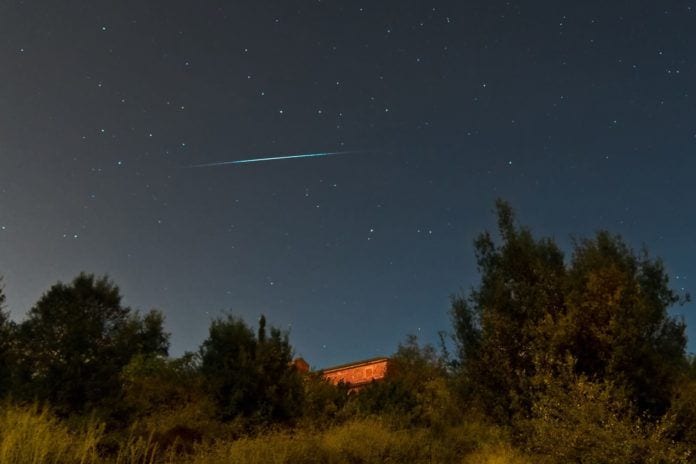Now you have another reason to stay out late in August: The Perseid meteor shower is streaking across the sky. The annual show, according to Space.com, comes to us courtesy of Comet Swift-Tuttle; the comet (16 miles wide at the nucleus) periodically passes by this way, and Earth orbits through the debris it left behind, which is what creates the Perseids — which are actually comet debris burning up as it enters our atmosphere.
Last year’s Perseids coincided with a new moon, making it an especially good year for viewing. That may not be the case this year, but you’ve still got a good shot at seeing some meteors. Want to see the Perseids? Then you’ll need to plan carefully, as light pollution in New Jersey can inhibit your view.
About the show
How many meteors will you see? Depends who you ask. According to the Spacedex website, which tracks meteor showers and sightings around the world, the Perseids won’t be quite as spectacular as they were last year because they coincide with a waxing gibbous moon and the moonlight may obscure the view; Spacedex predicts at least 80 meteors per hour, jumping up to 120 in rural locations. Space.com, however, predicts a good show because the Perseids will be in “outburst,” thanks to Jupiter’s gravity causing the comet debris to clump up more closely; the site says twice as many meteors as usual will appear, possibly more than 150 an hour.
When to go
Peak viewing, according to Spacedex, is August 12-13, between 11 p.m. and 4:30 a.m., though some meteors are viewable now. Space.com says August 12 is the peak, though the show will go on till August 24. It says the most meteors will be visible after midnight.
Either way, the key is to get outside before the full moon arrives on August 18 and outshines everything else.
Where to see it
Join a party. The D&R Greenway Land Trust in Princeton is holding its fourth annual Perseid Meteor Show Watch party on Aug. 11, starting at 11:30 p.m., at St. Michaels Farm Preserve in Hopewell Township. Visitors should park in the gravel lot on Princeton Avenue, and carpooling is recommended. D&R asks that you arrive at or close to 11:30 so as not to wreck anyone’s “night vision.” Volunteers from the Amateur Astronomers Association of Princeton are expected to provide assistance as needed. Reservations recommended; email rsvp@drgreenway.org with “Perseids” in the subject line. Check drgreenway.org for more info.
Additionally, the United Astronomy Clubs of New Jersey is planning a meteor viewing party, time and date to be determined, at its observatory at Jenny Jump State Forest, Great Meadows (near Hope). Follow the UACNJ’s Facebook page for updated info.
If you’re striking out on your own, you need dark, rural surroundings, so head away from bright lights and busy downtowns. Think Sussex or Warren counties up north, or Atlantic or Burlington counties down south. To get a better sense, check out the Light Pollution Map site, which uses satellite data courtesy of the National Oceanic and Atmospheric Administration’s Earth Observation Group to build its images. The redder the area is, the less of the night sky you’ll be able to see.
ObservingSites.com, which is produced and maintained by amateur astronomers, specifically names three places in the state for good nighttime views: the Paul Robinson Observatory at Voorhees State Park in High Bridge, run by the New Jersey Astronomical Association; the UACNJ facility in Great Meadows; and the recreation fields at Belleplain State Forest in Woodbine. (Check with the facilities for public viewing hours.)
Where to look
The Perseids are named after the constellation Perseus because that’s where they appear to come from, so orient yourself by finding Perseus and Cassiopeia first (they should be visible about 10 p.m.). Hang out awhile to get your eyes used to the darkness, then start meteorgazing.
Pro Tip: Don’t look directly up into the sky or you’ll miss them; look slightly away, or about halfway up into the sky, facing northeast, to get the full effect.
What to bring
Very little, actually. Just a blanket or chair, some bug spray and a heavy dose of patience. Coffee or hot chocolate is optional (but always delicious!). Or, find a campground and pack a tent for a meteoric all-nighter where the sky, indeed, is the limit.
Hero (Top) Feature Image: ©peresanz/Adobe Stock











